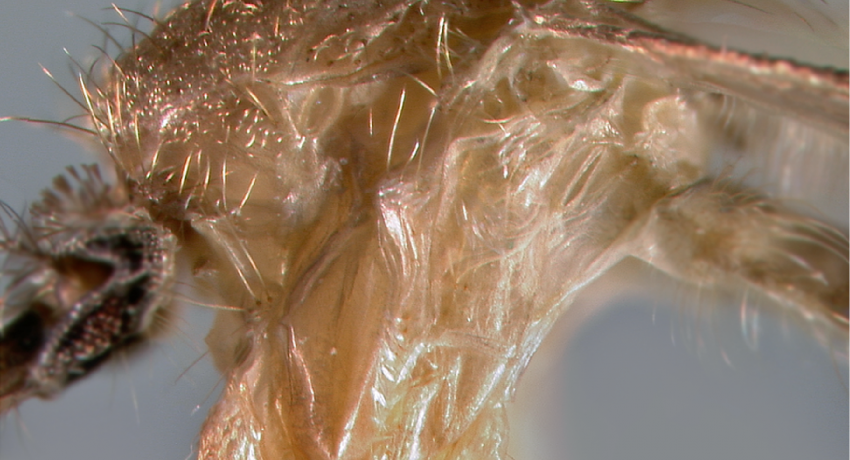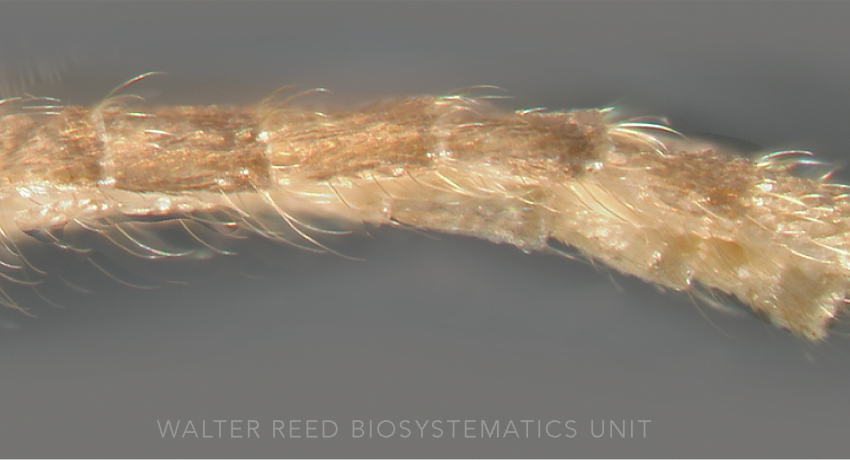AFROTROPICAL & PALEARCTIC REGIONS
Etymology: antenna (L); various antennal characters
Culex antennatus is a typical Culex (Culex) species with notably drab coloration and muted ornamentation. It belongs to the Decens Subgroup along with Cx. invidiosus, with its three valid subspecies (invidiosus Theobald, vicinalis de Meillon & Laviopierre, and vexillatus Edwards) and Cx. litwakae Harbach. Culex antennatus is reported from Turkey and the Middle East, through the Rift Valley into Africa as far south as Mozambique and Madagascar.
Type locality: Cairo, Egypt
Type depository: Zoologisches Museum der Humboldt Universität, Berlin, Germany (ZM)
DIAGNOSTIC CHARACTERS (Click photos to view; mouse over and click large photo to zoom in.)
ADULT (illustrated): Head: Proboscis (P) without pale bands. Thorax: Postspiracular scales absent; prealar scales absent; lower mesepimeron with at least one seta. Abdomen: Pale stripes of cream scales on VI,VII-Te and small pale spots on the lateral borders of II–V-Te (not visible in dorsal aspect). Legs: Ti-I–III and Fe-I,II with dark-scaled anterior surfaces; tarsomeres without pale bands.
LARVA (not illustrated): Head: Seta 1-C relatively long, slender; seta 5-C usually 2,3 branched. Abdominal segments: Seta 1-IV,V often >3-branched, relatively short, not reaching margin of following segment; seta 6-VI usually single. Terminal segments: Distal spines of pecten with 2–5 basal denticles; siphon index < 8.5; six pairs of seta 1-S, three of them lateral; seta 1-S tufts relatively short, not longer than diameter of siphon.
TAXONOMIC KEYS
Harbach 1988
Jupp 1996
Becker et al. 2010
![]()
WRBU – Culex (Culex) - West Africa Region – Adult
Exemplar DNA sequences
Cx. antennatus COI: KU187048, KU187050, KU187038, KU187037, MK033248.
BIONOMICS
Immatures
Immature Cx. antennatus are found in in a wide variety of freshwater ground habitats, including swamps, pools, rice fields, animal footprints and seepage drains with dense vegetation cover. They are occasionally found in brackish-water.
Adults
Female Cx. antennatus feed primarily on cattle and man, but will feast on other domestic livestock when cattle are scarce. Culex antennatus and Cx. pipiens Linnaeus, typically are among the most commonly-caught species indoors. Both will readily enter houses and feed on humans where cattle are absent. Blood meal analyses reveal evidence that Cx. antennatus collected indoors fed mainly on humans, while those collected outdoors fed mainly on domesticated livestock. Studies in Egypt, showed that Culex antennatus comprised 92–98% of all light trap catches during the 2003 RVFV outbreak.
DISTRIBUTION NOTES
Angola, Benin, Botswana, Burkina Faso, Cameroon, Cote d'Ivoire, Democratic Republic of the Congo, Egypt, Ethiopia, Iran, Iraq, Israel (and Gaza Strip & West Bank), Jordan, Kenya, Liberia, Madagascar (includes Glorioso & Juan De Nova Is), Mali, Mauritania, Nigeria, São Tomé & Príncipe, Senegal, Seychelles, Sudan & South Sudan, Tanzania, Turkey, Uganda

WRBU VECTOR HAZARD REPORTS
None; View other WRBU Vector Hazard Reports
Available GIS Models:
IMPORTANT REFERENCES (full citations below)
Séguy 1924: Pl.V (M genetics*, as Iaurenti)
Kirkpatrick 1925b: 129 (M*, F*, P*, L*; as laurenti)
Hopkins 1936: 224 (L; new combination)
Edwards 1941: 333 (M*, F*), 425 (P)
Larivière & Abonnenc 1956: 1195 (M*, L*, E*; bionomics, morphology)
Lotfi 1970: 400 (distribution; Iran)
Margalit & Tahori 1974: 86 (distribution)
Gad et al. 1987 (bionomics, distribution; Egypt)
Harbach 1988: 48 (M*, F, P*, L*; taxonomy, keys, bionomics, distribution, literature review)
da Cunha Ramos et al. 1992: 163 (distribution; Príncipe Island)
Jupp 1996 (M*, F*; key)
Amr et al. 1997 (distribution; Jordan)
Alten et al. 2000: 28 (distribution)
Becker et al. 2010: 328 (F*, L*; key, taxonomy, distribution, bionomics)
CURRENT SYNONYMS
syn. laurenti Newstead
1907: 24 (M, F). In: Newstead et al. 1907. Type locality: Leopoldville, Belgian Congo [Kinshasa, Democratic Republic of the Congo] (NHMUK). References: Hopkins 1936: 224 (synonymy); Harbach 1988: 48 (tax., review; as synonym of antennatus).
CITED REFERENCES
Alten, B., Caglar, S.S., & Ozer, N. (2000). Malaria and its vectors in Turkey. European Mosquito Bulletin, 7, 27–33.
Amr, Z.S., Al-Khalili, Y.H., & Arbaji, A. (1997). Larval mosquitoes collected from northern Jordan and the Jordan Valley. Journal of the American Mosquito Control Association, 13(4), 375–378.
Becker, N., Petrić, D., Zgomba, M., Boase, C., Madon, M., Dahl, C., & Kaiser, A. (2010). Mosquitoes and their control (Second ed.). Berlin Heidelberg: Springer-Verlag.
da Cunha Ramos, H., Ribeiro, H., Pires, C.A., & Capela, R.A. (1992). Os mosquitos (Diptera, Culicidae) da Îlha do Príncipe. García De Orta Serie de Zoologia, 16(1989)(1–2), 163–170.
Edwards, F.W. (1941). Mosquitoes of the Ethiopian Region. III. Culicine adults and pupae. Bulletin of the British Museum (Natural History) Entomology.
Gad, A.M., El Said, S., Soliman, B., Hassan, A.N., & Shoukry, A. (1987). Distribution and bionomics of Egyptian Culex univittatus (Theobald). Journal of the Egyptian Society of Parasitology, 17(1), 17–31.
Harbach, R.E. (1988). Mosquitoes of the subgenus Culex in southwestern Asia and Egypt (Diptera: Culicidae). Contributions of the American Entomological Institute, 24(1), 1–240.
Hopkins, G.H.E. (1936). Mosquitoes of the Ethiopian Region. I. Larval bionomics of mosquitoes and taxonomy of Culicine larvae. London, British Museum, 250pp.
Jupp, P.G. (1996). Mosquitoes of southern Africa. Culicinae and Toxorhynchitinae. Ekogilde Publishers, Hartebeespoort, South Africa, 156pp.
Hopkins, G.H.E. (1936). Mosquitoes of the Ethiopian Region. I. Larval bionomics of mosquitoes and taxonomy of Culicine larvae. London, British Museum, 250pp.
Kirkpatrick, T.W. (1925b). The mosquitoes of Egypt. Egyptian Govt Anti-Malaria Commission.
Larivière, M., & Abonnenc, E. (1956). Notes biologiques et morphologie de l'oeuf, de la larve et de l'adulte de Culex antennatus Becker 1903. Bulletin de l'Institut Fondamental d'Afrique Noire, 18, 1191–1199.
Margalit, J., & Tahori, A.S. (1974). An annotated list of mosquitoes in Israel. Israel Journal of Entomology, 9, 77–91.
Newstead, R., Dutton, J. E., & Todd, J. L. (1907). Insects and other Arthropoda collected in the Congo Free State. Annals of Tropical Medicine and Parasitology, 1, 1–112.
Séguy, E. (1924). Les moustiques de l'Afrique Mineure, de l'Egypte et de la Syrie. Encyclopedie Entomologique (A), 1, 1–257.
CITE THIS PAGE
Walter Reed Biosystematics Unit (Year). Culex antennatus species page. Walter Reed Biosystematics Unit Website, http://wrbu.si.edu/vectorspecies/mosquitoes/antennatus, accessed on [date (e.g. 03 February 2020) when you last viewed the site].










































































































































































